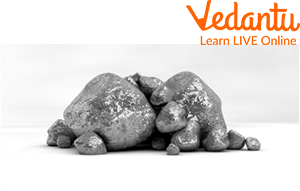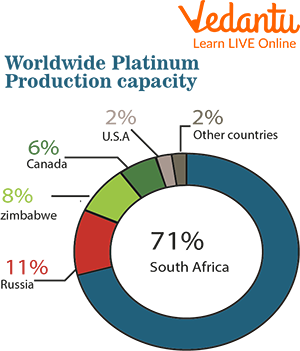




An Overview of Platinum
Could you name a precious silver and white metal which is used to make jewellery? Maybe your mum has a locket or a bracelet made from it. Let us give you one more hint. It is a type of metal which has good resistance to chemical attack and corrosion.
There are various metals which are used to make jewelleries, perhaps the one which is silver and has high resistance to chemical reactions is platinum. Platinum got its name from the Spanish word Platina which means little silver. Gold is the element that comes after Platinum. Let’s now see about its history, where platinum is commonly found and much more.

Appearance of Platinum
What Is Platinum?
Platinum is a silver and grey colour metal which is hard but stylish. It is found on the 10th column of the third row of the periodic table. Platinum has its chemical symbol as "Pt". The metal is transitioned and has an atomic number of 78. It has 78 protons and electrons and several 117 neutrons. Platinum has an atomic weight as 195.08
Palladium is an element which comes after platinum. The platinum group consists of various elements such as platinum, palladium, rhodium, ruthenium, iridium, and osmium. All these elements consist of similar properties and they occur together in nature.
History of Platinum
The only place where platinum was found earlier in the 1800s was in Colombia. After a few years, the existence of platinum was found in Russia. Later on, the one country where the metal was found in abundance to an extent that it became the largest supplier of it was Canada.
People started utilising platinum for making catalysts which increase the reaction of certain chemicals. After a quarter of a century, platinum was discovered in South Africa which supplies 75% of Platinum to the world and it is now the largest supplier of platinum.
Where Is Platinum Found?
The existence of platinum is very few in the world. A majority of 80% of platinum is found in South Africa and the second largest place is Russia, which is 10 percent and the rest is found in North and South America. Geographically, platinum is found underground, mostly in nuggets or grains and is usually plated with other metals, such as gold, nickel and copper ores or mineral sperrylite. It is rare to find platinum on its own.

Mining of Platinum in South Africa
Where is Platinum Found in Nature?
Platinum is the most precious metal that has been ever discovered. These are only 0.005 parts per million present on the planet, in comparison with the other metals like gold and silver
Where is Platinum Found in the World?
It is present in a few numbers on the earth. Research says that the availability of it is more on the moon or the metroids. Platinum is primarily found in compounds with other metals in the platinum-like group on the earth and must go through a mining and purifying process in order to be found and distributed for use.

Reserves of Platinum in Various Countries
Characteristics and Properties of Platinum
The characteristics of platinum are as follows:
The major characteristics of platinum include silver and greyish colour and extremely shiny. It is very ductile which means it is easily bendable and can be stretched and drawn into wire without breaking it.
Platinum has a high resistance to corrosion unlike most other metals when it contacts air it does not tarnish or rust. It is also very dense (one of the highest of the elements) and has a high melting point. Platinum has a high melting point of approximately a thousand degrees centigrade.
Though platinum has high chemical resistance, it can be dissolved in the combination of extremely high acidic chemical of nitric and hydrochloric also known as aqua regia
Platinum is extremely stable which means it is not reactive in the environment and it keeps its properties and usefulness intact. It is also known as a noble metal with these characteristics.
Uses of Platinum
Some uses of platinum are as follows:
Jewellery is frequently made of platinum. However, catalytic converters for vehicles, lorries, and coaches are where it is primarily used. Each year, this meets around 50% of the need. The conversion of engine emissions into less dangerous waste products is made possible by platinum.
In the chemical process industries, platinum is utilised as a catalyst in the manufacture of benzene, silicone, and nitric acid. To increase the effectiveness of fusion reactors, it is often used as a catalyst.
Platinum use is wide and more frequent in the electronic sector for the computer hard disks and thermocouples.
Additionally, gas turbines, LCD screens, spark plugs, cardioverters, and dental fillings are all made of platinum.
Important chemotherapeutic medications used to fight cancer include platinum compounds.
Summary
In the article, platinum for kids, we have discussed the history of platinum, where it is found, its characteristics and its uses. Platinum is also a chemical element, but it has some special properties that make it relatively hard to find in nature and expensive to extract. Platinum is mostly used as an electrical conductor because it doesn't corrode or chip easily when exposed to high temperatures or aggressive chemicals. Gold is the element that comes after platinum. We hope you have understood the concepts concerning the element platinum.
FAQs on Uses of Platinum
1. State any three facts about the platinum element.
The following are the three facts about platinum:
Russia's platinum coins were the world's first when they were introduced in 1828.
Platinum is extremely dense and, as a result, is among the hardest metals. Simply put, a block of platinum six inches on a side will weigh more than an average human being.
At a minimum of 95% purity, platinum is among the purest rare metals.
2. Does platinum have a higher value than gold?
There is a common belief that platinum is more valuable than gold. Due to platinum's superior rarity, density, and purity, it commands a higher price than gold. Platinum rings typically cost more since they require more platinum than gold rings.
3. Whether platinum is magnetic or not remains a mystery. Explain.
The precious metal platinum is widely used in various industries like jewellery, electronics, automobiles etc and it conducts electricity quite well and has various properties yet, it is not magnetic. However, when mixed with the right alloys, platinum can acquire a magnetic property all its own.









